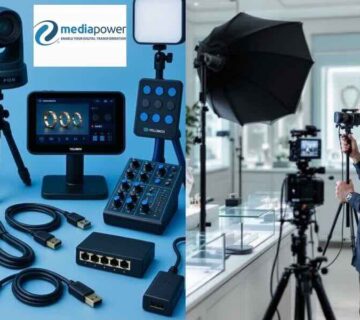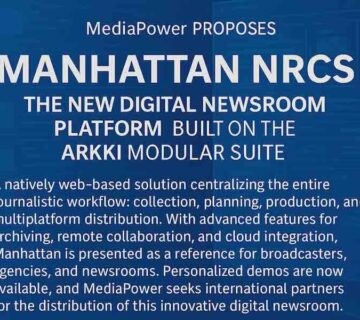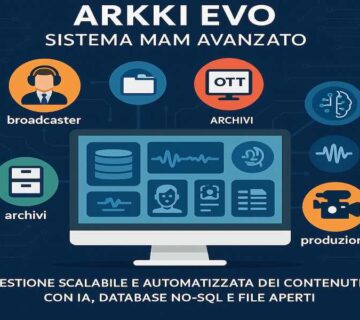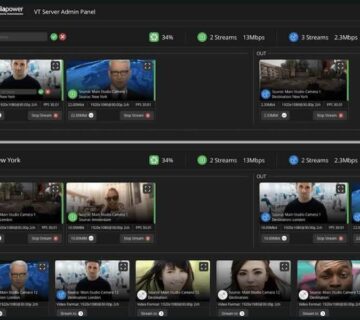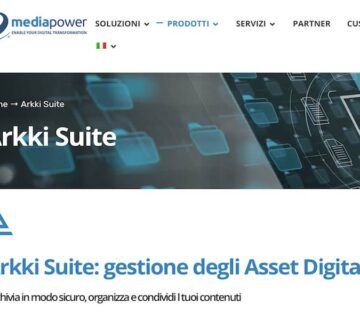
MediaPower, with over 30 years of experience, tackles the challenges of digital transformation by offering high-performance cloud solutions and software.
CEO Marcello Dellepiane emphasized the constant adaptation to a more competitive and complex market.
Between challenges and opportunities, highlights include 5G, remote production, HDR, immersive audio, cloud service maturity, and artificial intelligence.
Virtualization and SAAS revolutionize TV production, enabling greater flexibility and cost reduction.
The use of generative AI and machine learning transforms content production and distribution, providing personalization and improvements in metadata and localization.
The challenge lies in adapting to a context without traditional boundaries and continuously creating value for an increasingly demanding audience.
Let’s continue with this second and final part.
Presspool: “In this dynamic scenario, it seems that the television channel has lost some of its importance. What truly matters today are the customer and the content.”
MDP: “Creating value for the customer is crucial to keep them engaged across all media and channels.
This means not only offering quality content but also making it available on one or more user-friendly platforms that continue to generate value over time.
Capturing the audience’s attention is fundamental.
To engage the younger generation, it’s necessary to adopt a television approach optimized for mobile devices.
The critical challenge begins with content production, as TV content follows a specific 16:9 format, while smartphone-designed content is in vertical mode.
The transition without a clear distinction of content makes the process particularly complex, requiring the ability to create content suitable for both contexts.”
Presspool: “MediaPower is appreciated for dedicating time and energy to identify and disseminate trends that are expected to influence work today and tomorrow, such as software and format interoperability, etc. Do you believe your company has something more to offer?”
MDP: “Currently, I consider it crucial for the customer to become aware of the skills that are and will be essential and that, thanks to MediaPower, they can implement today for multi-platform monetization without making unnecessary investments.
We don’t limit ourselves to offering specialized and vertically focused knowledge but also dedicate ourselves to a horizontal understanding of the market, which is more useful than ever.
This approach is visible in our recent projects, where we collaborated within shared contexts.
In such situations, we not only shared the specific skills accumulated in our industry over the years but also engaged in ‘coopetition’ (a blend of cooperation and competition) with other entities, even if different, contributing to the success of the projects.
The crucial aspect is to provide our horizontal knowledge to generate value.”
Presspool: “Can you list a series of points that you consider among the most significant innovations in the Broadcast and Media sector and the impact they have produced?”
MDP: “The advent of streaming has led to audience fragmentation, a change in how consumers access content, and the availability of a wide choice of content never experienced before.
The change in how consumers access content, which can now be watched on any internet-connected device.
Increased competition, with the emergence of new OTT streaming platforms.
The numerical growth of over-the-top operators has put traditional linear television under pressure, forcing it to create new services to compete.
The relationship between content producers, broadcasters, and distribution platforms is evolving towards greater verticalization, with different actors seeking to control the entire value chain.”
Presspool: “Certainly a significant change. What challenges are associated with this innovation for you?”
MDP: “We could summarize with three points: firstly, the need to pursue new technologies, such as IP, cloud, and AI, requires significant investments to be implemented, to remain competitive in a fragmented, crowded, and constantly evolving market. Then the increasing competition from new platforms and competing operators. And lastly, the need to protect content from piracy.”
Presspool: “It is interesting to note that many challenges are at the same time opportunities. Is that correct?”
MDP: “Certainly, and regarding opportunities, we can summarize with two points: the possibility of reaching a wider audience, thanks to the international spread of the internet; and the opportunity to generate new revenue sources, thanks to new channels and business models. In particular, IP, cloud, and SAAS technologies are transforming the broadcast sector, making it more flexible, efficient, and sustainable.”
Presspool: “Interactivity, On-Demand and Personalized Content, and Immersive Experience can be considered among the opportunities?”
MDP: “Certainly, the interactivity and immersive experience of Augmented Reality (AR) and Virtual Reality (VR) could become increasingly important factors in future broadcast services, offering consumers new ways to enjoy increasingly personalized and valuable content. The demand for on-demand and ad-personam content will undoubtedly further drive streaming platforms and influence traditional programming.”
Presspool: “Market rumors report that MediaPower’s Operational Leasing service is positioned as a cornerstone for all the uncertainties that companies in these sectors face.”
MDP: “Indeed, operational leasing is a financial practice that MediaPower proposes to client companies and is based on unparalleled flexibility in managing their assets. In this model, our clients can use equipment without the need for a direct purchase. This type of contract allows enjoying the benefits of using the leased object without having to bear its full initial cost. This enables companies to remain agile in their operations, adapting quickly to the changing market needs that we have outlined. With operational leasing, new opportunities arise to optimize financial resources while maintaining a high level of efficiency and competitiveness.”
Presspool: “There is an increasing focus on issues related to sustainability and environmental impact. Are these becoming more relevant for MediaPower?”
MDP: “Environmental sustainability is certainly a central theme. The industry, including us at MediaPower, is increasingly trying to orient itself towards sustainable practices, reducing the environmental impact of production and distribution activities. But there is still much to plan and do in this perspective.”
Presspool: “I am aware that I am asking for quite an effort, but is it possible to trace an ‘almost conclusion’ that captures everything said in the two parts of this conversation, fixing it in January 2024?”
MDP: “We’ll try! According to MediaPower, every day is a challenge to manage reduced budgets, evaluate new technologies, handle change, and ensure adequate forms of support. In the future, we expect the media industry to continue developing hybrid monetization models, combining the strength of linear television with the precision of more targeted platforms. In 2024, the industry is expected to shift its focus towards profitability and efficiency, returning to more rational and scalable business models. A key theme that we haven’t covered here due to space constraints will be the merger of TV and digital advertising models to create a new model optimized for Connected TV (CTV). Additionally, we believe that the SMPTE ST 2110 standard will continue to consolidate as global for live production, highlighting the growing importance of IP technology in the media industry. Finally, in 2024, there will be a greater focus on green initiatives, with attention to reducing energy consumption and electronic waste.”
© 2024 Presspool PressOffice RobertoLandini
Tags:
#Broadcast sector, #Digital transformation, #Media consumption habits, # MediaPower, #Marcello Dellepiane, #5G, #Remote production, #Artificial intelligence, (#AI), #Virtualization, Sustainability, #TechnologicalInnovations, #ContentProduction, #CustomerEngagement,
Synopsis:
In the first part of the interview, MediaPower’s CEO Marcello Dellepiane discussed the profound transformation occurring in the broadcast sector due to new technologies and shifting content consumption habits. MediaPower, with its 30 years of experience, addresses these challenges through high-performance cloud solutions and software. Dellepiane highlighted the need for constant adaptation in a competitive market and identified key trends like 5G, remote production, HDR, and AI. Virtualization and SAAS are revolutionizing TV production, while AI transforms content production and distribution. The challenge lies in adapting to a boundaryless context and continuously creating value for a demanding audience. In this second part, Dellepiane discusses the importance of customer-centric content, MediaPower’s unique offerings, and significant innovations in the sector. Challenges include technological investments, competition, and piracy, but they also present opportunities like wider audience reach and new revenue sources. MediaPower’s operational leasing service provides flexibility amidst uncertainty, while sustainability becomes increasingly relevant. Looking ahead to 2024, the industry is expected to focus on hybrid monetization models, efficiency, and green initiatives, highlighting the importance of IP technology and the convergence of TV and digital advertising models.


